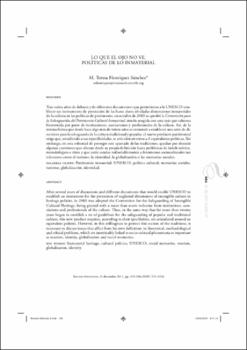Lo que el ojo no ve. Políticas de lo inmaterial
Date
2011Abstract
Tras varios años de debates y de diferentes documentos que permitieran a la UNESCO establecer
un instrumento de protección de las hasta ahora olvidadas dimensiones inmateriales
de la cultura en las políticas de patrimonio, en octubre de 2003 se aprobó la Convención para
la Salvaguardia del Patrimonio Cultural Inmaterial, siendo acogida con una más que calurosa
bienvenida por parte de instituciones, asociaciones y profesionales de la cultura. Así, de la
misma forma que desde hace algo más de veinte años se comenzó a establecer una serie de directrices
para la salvaguarda de la cultura tradicional y popular, el nuevo producto patrimonial
exige que, atendiendo a sus especificidades, se articulen en torno a él equivalentes políticas. Sin
embargo, en esta voluntad de proteger este apartado de las tradiciones, quedan por discutir
algunas cuestiones que afectan desde su propia definición hasta problemas de índole teórico,
metodológico o ético y que están unidas indisolublemente a fenómenos socioculturales tan
relevantes como el turismo, la identidad, la globalización o las memorias sociales. After several years of discussions and different documents that would enable UNESCO to
establish an instrument for the protection of neglected dimensions of intangible culture in
heritage policies, in 2003 was adopted the Convention for the Safeguarding of Intangible
Cultural Heritage, being greeted with a more than warm welcome from institutions, associations
and professionals of the culture. Thus, in the same way that for more than twenty
years began to establish a set of guidelines for the safeguarding of popular and traditional
culture, this new product requires, according to their specificities, are articulated around an
equivalent policies. However, in this willingness to protect this section of the traditions, is
necessary to discuss issues that affect from his own definition, to theoretical, methodological
and ethical problems, which are inextricably linked to socio-cultural phenomena so important
as tourism, identity, globalization and social memories.





